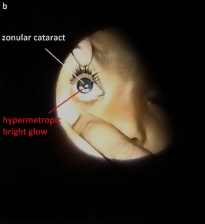Sudarshan Kumar Khokhar1, Amber Amar Bhayana1*, Priyanka Prasad1
1Dr. RP Centre for Ophthalmic Sciences, AIIMS, New Delhi, India
*Corresponding Author: Amber Amar Bhayana, Senior Resident, Dr. Rajendra Prasad Centre for Ophthalmic Sciences, All India Institute of Medical Sciences, New Delhi, India; Email: [email protected]
Published Date: 29-01-2021
Copyright© 2021 by Bhayana AA, et al. All rights reserved. This is an open access article distributed under the terms of the Creative Commons Attribution License, which permits unrestricted use, distribution, and reproduction in any medium, provided the original author and source are credited.
Clinical Image
Here hypermetropia in a 4 year old with zonular cataract (Fig. 1) is demonstrated with red reflex with indirect ophthalmoscopy as a bright area is seen in inferior part of the eye (Fig. 2) [1-3]. It is hard to pick up the same sign using red reflex with direct ophthalmoscope (Fig. 3) due to lesser distance between illumination and visualization axes in direct ophthalmoscope (as compared to indirect) allowing formation of better crescent that too just only through a peripheral rim of clear media in case of indirect ophthalmoscopy (Fig. 2,3) [2,3]. Axial length of the same eye as depicted was 19.68 mm on ultrasound A-scan and keratometry using autorefractor-keratometer was 46.5/47.5D@120o/30o. Cycloplegic refraction revealed a spherical equivalent of +6.5D. We would thus like to propose that red reflex test with indirect ophthalmoscope can be done to elicit refractive errors even in cases of media opacity provided some area even so in periphery as in our case permits reflex formation.
References
- Kothari MT. Can the Bruckner test be used as a rapid screening test to detect significant refractive errors in children? Indian J Ophthalmol. 2007;55:213-5.
- Bhayana AA, Prasad P, Azad SV. Refractive errors and the red reflex- Bruckner test revisited. Indian J Ophthalmol. 2019;67:1381-2.
- 3. Bhayana AA. Response to comments on: Using Brückner’s test for gross keratometry screening. Indian J Ophthalmol. 2020;68:263.
Article Type
Clinical Image
Publication History
Received Date: 05-01-2021
Accepted Date: 23-01-2021
Published Date: 29-01-2021
Copyright© 2021 by Bhayana AA, et al. All rights reserved. This is an open access article distributed under the terms of the Creative Commons Attribution License, which permits unrestricted use, distribution, and reproduction in any medium, provided the original author and source are credited.
Citation:Bhayana AA, et al. Refractive Red Reflex Test in Zonular Cataract. J Ophthalmol Adv Res. 2021;2(1):1-2.

Figure 1: Right eye of the child showing zonular cataract.

Figure 2: Indirect distant ophthalmoscopy of the same eye showing central opacity of zonular cataract with inferior bright glow signifying hypermetropia.

Figure 3: Direct distant ophthalmoscopy of the same eye showing central opacity of zonular cataract with poor evidence of any refractive errors as far as crescent formation is concerned.


